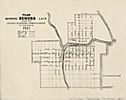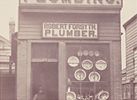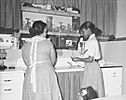Nineteenth-century Chicagoans needed water for many things, but most fundamentally for drinking and fire protection. As the city population grew to the point where residents did not have direct access to the lake, river, or well, a public water system was laid out. The immediate needs of urban residents could have been accomplished through communal fountains, but water developed into an amenity as well as a necessity. Chicagoans devised ways to bring water into their houses, transforming their most private lives with indoor toilets, bathing facilities, and kitchens. Indoor plumbing emerged as an amenity which only the wealthiest Chicagoans could readily afford in the mid-nineteenth century. However, mass production of fixtures and other improvements, put indoor plumbing within reach of many more Chicagoans by the 1910s. The bungalow boom of the 1920s signaled the arrival of indoor plumbing as standard in working-class houses.
Photo Essay Sections:
|
|
|
|
The Encyclopedia of Chicago © 2004 The Newberry Library. All Rights Reserved. Portions are copyrighted by other institutions and individuals. Additional information on copyright and permissions.


